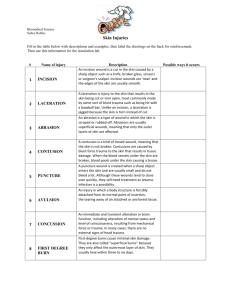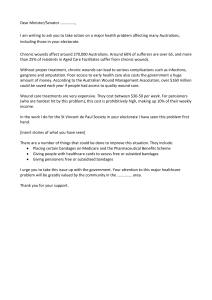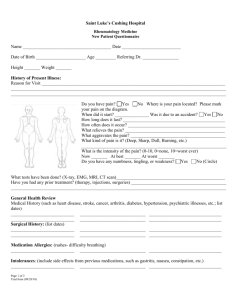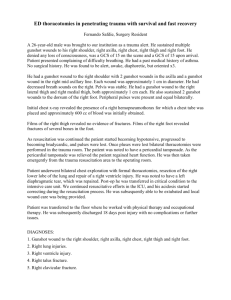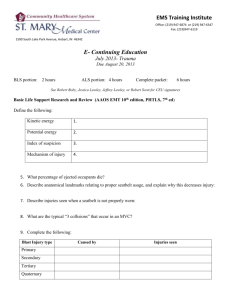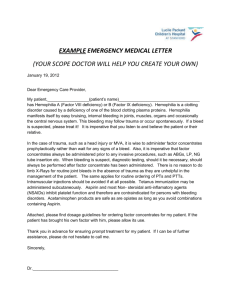i assert
advertisement
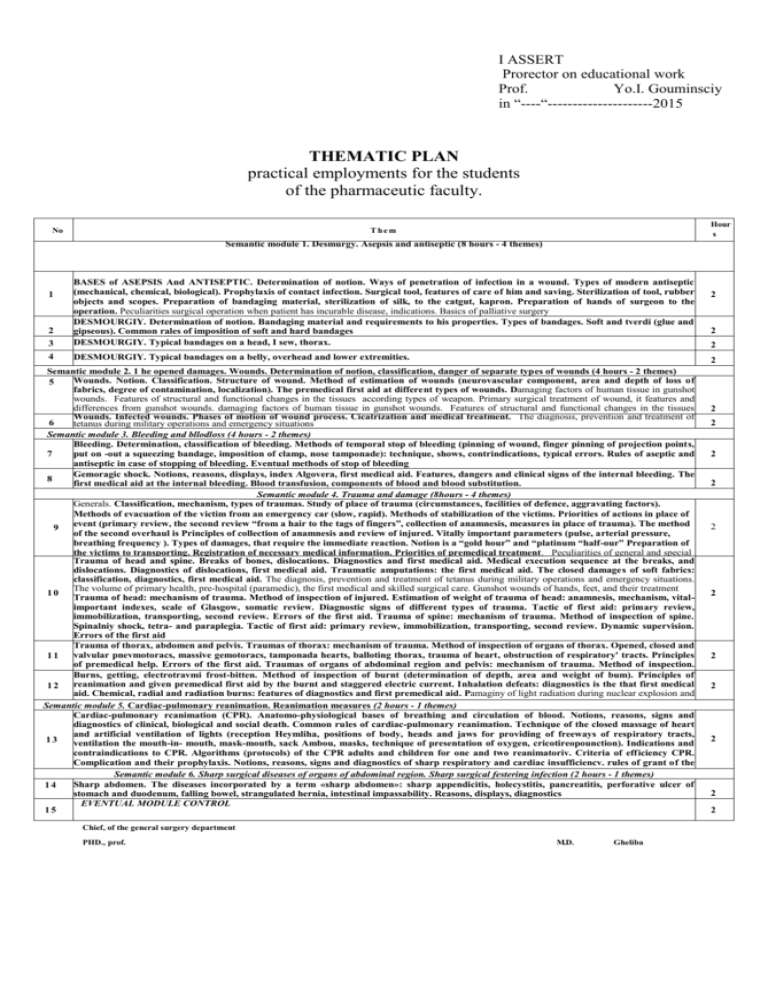
I ASSERT Prorector on educational work Prof. Yo.I. Gouminsciy in “----“---------------------2015 THEMATIC PLAN practical employments for the students of the pharmaceutic faculty. No Hour s T he m Semantic module 1. Desmurgy. Asepsis and antiseptic (8 hours - 4 themes) 3 BASES of ASEPSIS And ANTISEPTIC. Determination of notion. Ways of penetration of infection in a wound. Types of modern antiseptic (mechanical, chemical, biological). Prophylaxis of contact infection. Surgical tool, features of care of him and saving. Sterilization of tool, rubber objects and scopes. Preparation of bandaging material, sterilization of silk, to the catgut, kapron. Preparation of hands of surgeon to the operation. Peculiarities surgical operation when patient has incurable disease, indications. Basics of palliative surgery DESMOURGIY. Determination of notion. Bandaging material and requirements to his properties. Types of bandages. Soft and tverdi (glue and gipseous). Common rales of imposition of soft and hard bandages DESMOURGIY. Typical bandages on a head, I sew, thorax. 4 DESMOURGIY. Typical bandages on a belly, overhead and lower extremities. 1 2 2 2 2 Semantic module 2. 1 he opened damages. Wounds. Determination of notion, classification, danger of separate types of wounds (4 hours - 2 themes) Wounds. Notion. Classification. Structure of wound. Method of estimation of wounds (neurovascular component, area and depth of loss of 5 fabrics, degree of contamination, localization). The premedical first aid at different types of wounds. Damaging factors of human tissue in gunshot wounds. Features of structural and functional changes in the tissues according types of weapon. Primary surgical treatment of wound, it features and differences from gunshot wounds. damaging factors of human tissue in gunshot wounds. Features of structural and functional changes in the tissues Wounds. wounds.Primary Phasessurgical of motion of wound process. Cicatrization and medical The diagnosis, prevention and treatment of according Infected types of weapon. treatment of wound, it features and differences fromtreatment. gunshot wounds 6 tetanus during military operations and emergency situations Semantic module 3. Bleeding and bllodloss (4 hours - 2 themes) Bleeding. Determination, classification of bleeding. Methods of temporal stop of bleeding (pinning of wound, finger pinning of projection points, 7 put on -out a squeezing bandage, imposition of clamp, nose tamponade): technique, shows, contrindications, typical errors. Rules of aseptic and antiseptic in case of stopping of bleeding. Eventual methods of stop of bleeding Gemoragic shock. Notions, reasons, displays, index Algovera, first medical aid. Features, dangers and clinical signs of the internal bleeding. The 8 first medical aid at the internal bleeding. Blood transfusion, components of blood and blood substitution. Semantic module 4. Trauma and damage (8hours - 4 themes) Generals. Classification, mechanism, types of traumas. Study of place of trauma (circumstances, facilities of defence, aggravating factors). Methods of evacuation of the victim from an emergency car (slow, rapid). Methods of stabilization of the victims. Priorities of actions in place of 9 event (primary review, the second review “from a hair to the tags of fingers”, collection of anamnesis, measures in place of trauma). The method of the second overhaul is Principles of collection of anamnesis and review of injured. Vitally important parameters (pulse, arterial pressure, breathing frequency ). Types of damages, that require the immediate reaction. Notion is a “gold hour” and “platinum “half-our” Preparation of the victims to transporting. Registration of necessary medical information. Priorities of premedical treatment. Peculiarities of general and special Trauma of head and spine. Breaks of bones,patients, dislocations. Diagnostics and first medicalwith aid.corpse Medical execution sequence at the breaks, and care of patients in critical condition, of incurable patients in agony. Basics of behavior dislocations. Diagnostics of dislocations, first medical aid. Traumatic amputations: the first medical aid. The closed damages of soft fabrics: classification, diagnostics, first medical aid. The diagnosis, prevention and treatment of tetanus during military operations and emergency situations. The volume of primary health, pre-hospital (paramedic), the first medical and skilled surgical care. Gunshot wounds of hands, feet, and their treatment 10 Trauma of head: mechanism of trauma. Method of inspection of injured. Estimation of weight of trauma of head: anamnesis, mechanism, vitalimportant indexes, scale of Glasgow, somatic review. Diagnostic signs of different types of trauma. Tactic of first aid: primary review, immobilization, transporting, second review. Errors of the first aid. Trauma of spine: mechanism of trauma. Method of inspection of spine. Spinalniy shock, tetra- and paraplegia. Tactic of first aid: primary review, immobilization, transporting, second review. Dynamic supervision. Errors of the first aid Trauma of thorax, abdomen and pelvis. Traumas of thorax: mechanism of trauma. Method of inspection of organs of thorax. Opened, closed and 1 1 valvular pnevmotoracs, massive gemotoracs, tamponada hearts, balloting thorax, trauma of heart, obstruction of respiratory' tracts. Principles of premedical help. Errors of the first aid. Traumas of organs of abdominal region and pelvis: mechanism of trauma. Method of inspection. Complications for the life (intraabdominal peritonitis, Burns, getting,threatening electrotravmi frost-bitten. Method of bleeding, inspection of burnt evisceration) (determination of depth, area and weight of bum). Principles of 1 2 reanimation and given premedical first aid by the burnt and staggered electric current. Inhalation defeats: diagnostics is the that first medical aid. Chemical, radial and radiation burns: features of diagnostics and first premedical aid. Pamaginy of light radiation during nuclear explosion and incendiary Semantic module 5. Cardiac-pulmonary reanimation. Reanimation measures (2 hours - 1 themes) Cardiac-pulmonary rcanimation (CPR). Anatomo-physiological bases of breathing and circulation of blood. Notions, reasons, signs and diagnostics of clinical, biological and social death. Common rules of cardiac-pulmonary reanimation. Technique of the closed massage of heart and artificial ventilation of lights (reception Heymliha, positions of body, heads and jaws for providing of freeways of respiratory tracts, 13 ventilation the mouth-in- mouth, mask-mouth, sack Ambou, masks, technique of presentation of oxygen, cricotireopounction). Indications and contraindications to CPR. Algorithms (protocols) of the CPR adults and children for one and two reanimatoriv. Criteria of efficiency CPR. Complication and their prophylaxis. Notions, reasons, signs and diagnostics of sharp respiratory and cardiac insufficiencv. rules of grant of the first premedical aid. Peculiarities of surgical first aid and basicofresuscitation of incurable patients Semantic module 6. Sharp diseases organs of abdominal region. Sharp surgical festering infection (2 hours - 1 themes) Sharp abdomen. The diseases incorporated by a term «sharp abdomen»: sharp appendicitis, holecystitis, pancreatitis, perforative ulcer of 14 stomach and duodenum, falling bowel, strangulated hernia, intestinal impassability. Reasons, displays, diagnostics EVENTUAL MODULE CONTROL 15 Chief, of the general surgery department PHD., prof. 2 M.D. Gheliba 2 2 2 2 2 2 2 2 2 2 2
